26081 Merit Circle Suite #109
Laguna Hills, CA 92653
(949- 582-7699
(949) 582-SKIN
Fax (949) 582-7691
Author: Dr. Nili Alai
Efudex (fluorouracil)
Efudex ( fluorouracil)is a topical cream that has remained the GOLD STANDARD for treatment of pre-cancers called actinic keratosis. It is an optional treatment for fair skin individuals with multiple or recurrent actinic keratosis. It is particularly useful for those with a history of strong sun exposure or a personal or family history of skin cancer. Efudex is used for 2-6 weeks depending on the area being treated. It is a selective cream that attacks only pre-cancers and early basal cell cancers. Efudex acts like a private detective in that you treat an entire area and it selectively finds the damaged areas and treats them. If there is no skin damage, there is no reaction and no redness or irritation. If however, there is even invisible damage, it highlights these areas and treats them. It really isn’t as useful for more developed or advanced skin cancers and can’t clear these like pre-cancers. The goal of your therapy with Efudex is to be pro-active and potentially cut down on your total number of pre-cancers and future skin cancers.
Most patients use the cream twice a day for 4 weeks from start to finish. It is usually best to treat an area and not spot treat. Most patients choose to treat the entire face at once although a few prefer to treat one cheek or section at a time. The treated areas may begin to get itchy, red, irritated, or sensitive by 10-14 days. Once you finish the full 4 week treatment, the areas calm down over the next 1-3 weeks. There are multiple other treatment alternatives for patients who are unable or don’t wish to have Efudex treatment. These include freezing ( liquid nitrogen), Photodynamic therapy or Blue Light ,Solaraze, Aldara, ALA/ laser treatments, facial peels, etc.
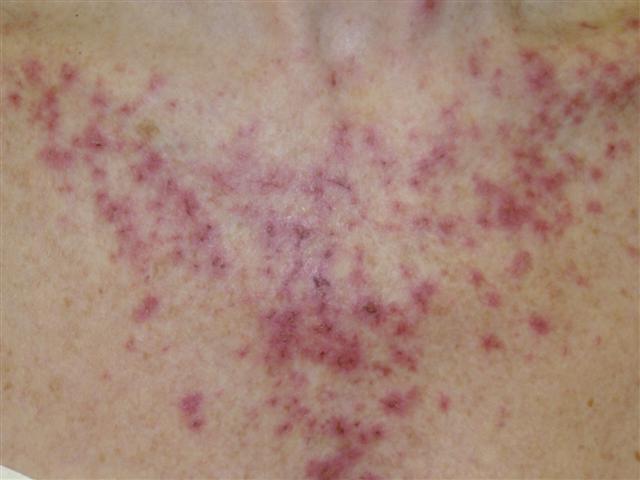
1. Only per your physician, begin Efudex cream twice a day to one area only.
Typical treatment area may include the face, ears, scalp, chest, back, shoulders, nose, arms, or back of the hands hands. It is important to limit the treatment area and do not treat more than one area at a time.
(The lower lip is a special area and very sensitive skin: treatment is usually only once a day to lower lip for 7-10 days)
2. Use a hat daily and avoid intense sun exposure. Recommended sunscreens are zinc or titanium based non-chemical sunscreens like Physicians Complex SPF 30 w/ zinc, Neutrogena SPF 30 sensitive skin w/ Titanium, Presun zinc sunscreen.
3. Stop any other irritating creams such as glycolic acic products, retin A, Tazorac, etc. to the are a. You may use bland makeup/cover-up as long as it doesn’t sting or cause you discomfort.
a. You may use bland makeup/cover-up as long as it doesn’t sting or cause you discomfort.
4. Use a topical cortisone to help decrease itching or irritation while using Efudex.
Apply Locoid Lipocream, Cortaid, Desowen lotion, Desonide Lotion, or Hydrocortisone cream, two to three times a day only if needed for itching or irritation. Don’t need to use the cortisone cream if don’t have any irritating symptoms when using Efudex. Its best to apply the cortisone an hour or so after applying the Efudex, not with the Efudex.
5. Return for your half way re -check with your dermatologist in 10-14 days AFTER you start Efudex. (VERY IMPORTANT)
6. If you are having a lot of trouble and other side effects, stop the cream and then call us for a sooner appointment.
7. Do not use the cream in or around your eyes and inside lips. Do not use in crevices like corners of your mouth or the nasal folds. This can cause a rash and become very irritated.
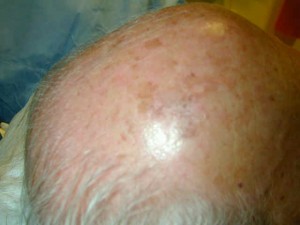
SCALP: one of the most common areas for actinic keratosis in men.
Typical prescirption may use Efudex twice a day for 4 weeks for the scalp.
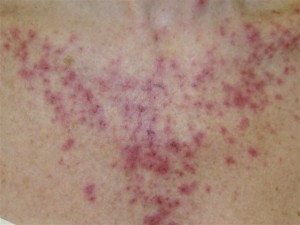
Chest: common area for actinic keratosis ( pre-cancers) especially in women.
Typical prescription from physician may use Efudex twice a day for 4 weeks.
Dr. Nili Alai is a Board-Certified Dermatologists.
For more information, please call (949) 582-7699 or visit the practice website at www.lagunaskincenter.com.
| Frequently Asked Questions |
| Why has my doctor prescribed EFUDEX®? |
| Because it’s the leading topical treatment for treating precancerous actinic keratoses (AKs) and superficial basal cell carcinoma (sBCC), a common form of skin cancer.1 These lesions are caused by sun exposures. |
| Is EFUDEX® only for older people? |
| No. EFUDEX® is for any adult. However, it is not approved for use in children. Younger people are being diagnosed with sBCC resulting from sun exposure and are being treated with EFUDEX®.9 |
| How many people have used EFUDEX®? |
| Over 14 million prescriptions have been written for EFUDEX® over the last 30 years.5 |
| Where can I find EFUDEX®? |
| EFUDEX® is available in most retail pharmacies. Simply take your prescription to the pharmacy you normally use. |
| How successful is EFUDEX® in treating precancerous actinic keratoses (AKs)? |
| In medical studies, up to 86% of visible lesions treated with EFUDEX® were completely eliminated.1 |
| How successful is EFUDEX® in treating superficial basal cell carcinoma? |
| EFUDEX® 5% Cream or Solution has a 93% success rate for sBCC lesions.1 |
| When is the best time of day to apply EFUDEX®? |
| Morning and evening, as part of your normaly daily routine, or as instructed by your physician. Patients being treated for AKs typically use EFUDEX® twice a day for 2 to 4 weeks. For sBCC, patients would use EFUDEX® twice a day for at least 3-6 weeks, and up to 10-12 weeks. |
| How do I use EFUDEX®? |
|
| How much EFUDEX® should I apply? |
| Every case of AK and sBCC is unique, so your doctor will give you specific instructions for using EFUDEX®. Generally, though, apply enough EFUDEX® to completely cover the lesions. |
| What will happen to my skin when I use EFUDEX®? |
You will see the effect of EFUDEX®on your skin in 4 phases:
|
| How can I tell the difference between a normal reaction to EFUDEX® and an allergic reaction? |
| Itching, burning, soreness, tenderness, scaling, and swelling are common reactions to EFUDEX® therapy. An allergic reaction should be suspected when a patient complains of marked itching and discomfort. If you are concerned about the side effects you’re experiencing, talk to your doctor. He or she can best assess the situation and more fully answer your questions. |
| Will EFUDEX® cause scarring to my skin? |
| Unlike other treatment options, EFUDEX® is not likely to leave scars or make patches of skin permanently discolored. In fact, many patients have reported that, after treatment, their skin was smoother, with a more even tone. |
| Will my face bleed or peel? |
| During the first 2 to 4 weeks of treatment with EFUDEX®, the treated areas will probably turn red and look and feel irritated. This is typical and should not cause concern. The red means it’s working. You will probably experience crusting and peeling but not bleeding. |
| Does EFUDEX® cause any side effects? |
| The most frequent side effects of EFUDEX® Topical Solutions and Cream occur locally and may include itching, burning, soreness, tenderness, rash, scaling, scarring, photosensitivity, and swelling. If any of these occur, contact your doctor; he or she may have ideas for how to minimize these effects. |
| What do I say to people who ask why my face is bright red and peeling? |
| Tell them you’re using a topical drug that treats your skin for AKs and sBCC. The drug makes your face red while it eliminates unhealthy cells, and leaves you with healthy skin. |
| Can I use EFUDEX® anywhere on my body? |
| EFUDEX® is the only topical treatment approved by the FDA to be used almost anywhere on the skin, including the face, scalp, hands, arms, shoulders, and trunk. However, application of EFUDEX® to mucous membranes should be avoided.1 In addition, EFUDEX® should not be applied in the eyes. |
| Can I use EFUDEX® on hairy areas of my body? |
| When AKs or sBCC occur in your hair, your doctor may recommend EFUDEX® Solution, which can easily penetrate through hairy areas. Simply hold the container, which has a built-in applicator, against the affect areas and squeeze until a small amount reaches the skin. |
| I noticed some spots on my legs that I forgot to show my doctor. Can I use EFUDEX® there, too? |
| Only your doctor can determine if the “spots” you have are AKs or sBCCs and can be treated with EFUDEX®. This is why it is so important to use EFUDEX® only as directed and discuss any questions you may have with your doctor. |
| Can I use cosmetics or other skin products while using EFUDEX®? |
| Patients are advised not to use cosmetics or any other skin products, including creams, lotions, and medications, while on EFUDEX® therapy unless instructed by their doctor. |
| Should I avoid the sun while using EFUDEX®? |
| During EFUDEX® treatment, you should do everything possible to stay out of the sun. However, with an active lifestyle, this isn’t always possible. So be sure you take every precaution to protect your skin. Wear long sleeves and a hat when you go outside, and ask your doctors about the use of sunscreen on areas that aren’t covered by clothing. |
| What should I do if I forget an application of EFUDEX®? |
| Simply resume using it as prescribed by your doctor. Do not increase or double your dose. |
| Are there people who should not use EFUDEX®? |
| EFUDEX® should not be used in women who are or may become pregnant during therapy because it may cause harm to the fetus. If you are nursing, be sure to let your doctor know because it is not known whether EFUDEX® is excreted in human milk. Also, EFUDEX® should not be used by people who are known to be allergic to any of its components. |
| Is there anything else I need to know about EFUDEX® therapy? |
|
| What kind of follow-up care Is needed? |
| You should visit your doctor after therapy to plan your follow-up care, including regular appointments to make sure new lesions are not developing. |
| What should I do with any EFUDEX® that is left over after I complete therapy? |
| Discard any unused portion of EFUDEX® after you have completed therapy. |

Rapid Clearance of AKs
Efficacy is achieved in as little as 2 weeks1
- Cures up to 86% of visible AK lesions in just 2-4 weeks1
- Additional AK lesions were also detected and resolved during treatment6,7

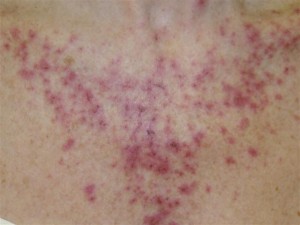
Benefits of EFUDEX®
- Starts working within the first week of treatment8
- Provides rapid resolution of AK lesions6,7
- Offers excellent cosmetic outcome7
Solar of Actinic Keratoses (AK) may Develop into Squamous Cell Carcinoma2
- AKs represent the earliest stages of squamous cell carcinoma (SCC)2
- Since the 1960′s, the incidence of SCC has been increasing 4% to 8% per year9
- Squamous cell skin cancer affects about 100,000 Americans each year9
- 2,000 to 2,500 Americans die each year due to SCC of the skin2
- Patients may have up to 10 times as many subclinical/undetected lesions for each visible AK10
- Younger patients are developing AKs3
Proven Efficacy in sBCC(5% Strength)1The Cure Rate for EFUDEX®is consistently high

- 93% cure rate in sBCC1
- At least 3-6 weeks, and up to 10-12 weeks sBCC treatment duration
EFUDEX® offers benefits when conventional methods are impractical
- Minimizes the risk of hypopigmentation11
- Provides an effective option for large and difficult to treat areas11
- Treats surrounding AK lesions1
sBCC is among the most common types of skin cancer
- BCC makes up about 80% of all skin cancers9
- An increased incidence of sBCC in younger patients may be due to greater sun exposure3
- sBCCs represent approximately 15% of BCCs12
Trust the experience of EFUDEX® in both sBCCs and AKs
- Over 30 years of proven clinical experience8
- Over 14 million prescriptions since 19725
- EFUDEX® is the #1 prescribed topical 5-FU13
Important Safety InformationEFUDEX® is contraindicated in women who are, or may become, pregnant during therapy because of potential hazards to the fetus. Cases of miscarriage and birth defects have been reported in women who are pregnant. The most frequent adverse events occur locally and may include itching, burning, soreness, tenderness, rash, scaling, scarring, photosensitivity, and swelling. Application to mucous membranes should be avoided due to the possibility of local inflammation and ulceration.
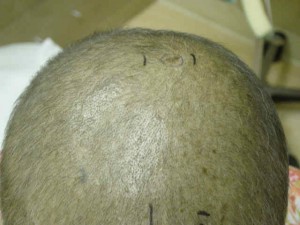
Information in this publication and site is not intended to serve as medical advice. Individuals may use the information as a guide to discuss their treatments with their own physicians. This site does not promote nor endorse the unauthorized practice of medicine by non-physicians or state licensed health care providers.
Medicine is a constantly changing science and not all therapies are clearly established. New research changes drug and treatment therapies daily. The authors, editors, and publisher of these articles have used their best efforts to provide information that is up-to-date and accurate and is generally accepted within medical standards at the time of publication. However, as medical science is constantly changing and human error is always possible, the authors, editors, and publisher or any other party involved with the publication of this article do not warrant the information in this article is accurate or complete, nor are they responsible for omissions or errors in the article or for the results of using this information. The reader should confirm the information in this article from other sources prior to use. In particular, all drug doses, indications, and contraindications should be confirmed in the package insert.
Copyright © 2003-2010 The Skin Center. All rights Reserved.
